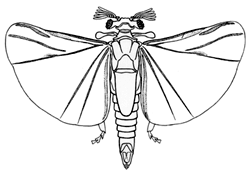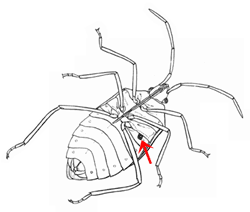|
Strepsiptera:
stylops
Characteristics
These
insects are very small parasites
of other insects and are rarely seen as they spend most of their
life within the host. Males can appear very different from females
are their distinguishing characteristics are given below:

Halictophagus species |
|
Male
Strpsiptera
-
1-8
millimetre wingspan
- Large
berry-like eyes
- Fan-shaped
antennae
- Forewings
reduced to knobs (similar to the halteres of flies)
- Large
membranous
hind wings with reduced venation
- Mouthparts
are reduced and non-functional
|

Halictophagus species |
|
Female
Strpsiptera
- Larvae-like
body
- Wingless
- Legless
- Reduced
mouthparts
Larvae
appear grub-like
|
Life Cycle
Stylopids
reproduce sexually and females most likely protrude through the
abdomen of the host and release pheromones
to attract males. After mating the eggs develop and hatch into first
instar
larvae
within the females body. They then make their way out through her
genital opening to find a new host. At this stage the larvae
are active, have long thin legs and are able to jump distances up
to a few centimetres. After finding a host the larvae
burrows in through the cuticle and moults
into a legless second instar
which completes development within the body of the host. Most stylopids
pupate
protruding from the host and emerge without killing it. Males will
fly off to find a female to mate with while females will emerge
and stay on the original host.
Feeding
All species
of female and larvae
stylopids parasitise
a variety of insect orders with most not confined to a single host
species. Male stylopids have greatly reduced mouthparts and do not
feed.
Habitat
Stylopids
are found over much of the country and in Australia they mostly
parasitise
bugs (Hemiptera) although some other insect orders such as Orthoptera
and Blattodea are affected. The free living stages of this order
are rarely found. Most male Halictophagus species (above)
are parasites
of Cicadellidae species (Hemiptera).
|